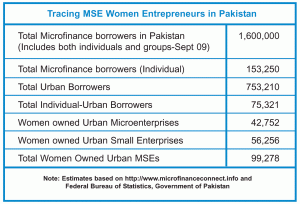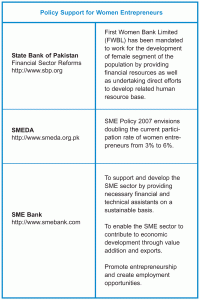This article discusses the policy-related issues for women entrepreneurs (WEs) operating in the MSE (micro and small enterprises) sector in Pakistan. It argues that most of the women-owned enterprises fall in the category of MSEs and not SMEs and hence deserve a separate policy level attention in the form of a new gender-sensitive, MSE Policy.
A survey by the State Bank of Pakistan suggests that an over whelmingmajority of SMEs are small proprietorship firms employing less than 20 workers, which signifies the need for separately addres-sing Micro and Small Enterprise (MSE) issues. A survey conducted by SMEDA suggests that almost 84 percent of SMEs operating in Pakistan earn less than Rs. 500,000 annual revenue whereas 99 percent of SMEs have fixed assets worth less than 1 million rupees including land and buildings.
It may be noted that under the current policy, a firm earning Rs. 500,000 and having only 2 employees is bracketed with a firm earning Rs. 250 million having 250 employees. For policy makers, both these firms are SMEs! We argue that these firms are structurally apart and looking at them from a same policy lens leads to poor resource allocation.
MSEs remain largely un-served/underserved by banks and business development service providers, and are more vulne-rable to shocks like energy shortages, rising energy costs, and inflation. Where the reported credit extended to the SME sector is growing, commercial banks routinely conceal any information on the size and nature of the borrowing firms which means we remain largely ill-informed about the credit extended to the MSE sector at large, as they are bracketed with the medium scale organizations. This also calls for treating the small, including the micro sector, differently from the medium.
Overview of Women-Owned MSE Sector
Close to 100,000 enterprises in the MSE sector are owned and
managed by women entrepreneurs in urban areas alone.
Potential Number of WEs transforming from Micro to Small
These are the women entrepreneurs who have the potential too utgrow the microfinance sector and enter the larger, more competitive landscape of the MSE sector. It is estimated that close to 13,000 such women entrepreneurs would now fall under this ‘growth probable’ category.
Policies and programmes designed to cater to this category are needed to help women entrepreneurs grow and succeed at a larger scale. A leading micro-finance institution, Kashf Foundation, did envisage this programme, but it did not achieve any meaningful implementation .
The key reason offered by Kashf Foundation itself was its preoccupation with a fast growing micro borrowers market. There is no programme in place at the moment that can help prospective women entrepreneurs to grow from micro to small enterprises.
Policy Environment
As above table shows, while there are some programmes and institutions focused on women entrepreneurship development, WEs do not receive any special policy preference except perhaps in the case of SMEDA. SMEs do not access banks for loans; 70 percent would prefer to borrow from friends and families, which are easily and immediately available. This means that if banks want to sell loans to SMEs, they must compare their product with the ones offered by friends, families, or other informal channels. Key characteristics of this informal channel: quick access, reliability, cheap or free loan, and small amounts. If an entrepreneur needs money, and banks do not offer similar terms, the entrepreneurs will tend to return to better-known sources. This limits the amount of investment and growth that can take place in the MSE in question.
Recommendations
1.A New Policy for the MSE Sector
We call for a separate defi-nition and a new policy for MSEs. This would enable policymakers both in the financial and real sector to formulate more focused and responsive policies, products, and initiatives for enhancing the capacity of MSEs and for improving their access to financial and business development services.
2.Incentives for WEs
Microfinance institutions offer loans that are more expensive than commercially available loans. There should be a provision in the microfinance lending policy that banks be allowed to extend loans on commercial rates to selected female microentrepreneurs. Besides favourable rates, the lending institutions must offer products that are comparable to their biggest competitor, the informal credit market.
3.Skill building for WEs
Microfinance institutions and microfinance banks should be encouraged and facilitated to set up training facilities for selected women entrepreneurs who demonstrate success. This may include assistance in business plan preparation and access to markets as well as new sources of financing.
4.Active donor participation
Investment in entrepreneurship, with a preference for women entrepreneurs, has become a hallmark of almost all international donors wor-king in Pakistan. Donors like USAID, CIDA, and CIPE have invested in female entrepreneurship development as a priority area and several projects have been already rolled out. The networks of women entrepreneurs need to approach them and seek their assistance.
5.Foster entrepreneurial network
As micro and small enter-prises cannot possibly achieve economies of scale, the banks and other business support organizations should extend incentives for vertical and horizontal collaboration amongst MSEs. These incentives can take the form of a grant for a common facility center, subsidized trainings for larger groups, support for designing facility, technical assistance in quality assu-rance and access to markets.
6.Improve research on MSE sector
Besides the typical implementation problems, policies usually fail because they are not based on detailed know-ledge about the stakeholders. International donors should be approached to consider conducting research on the unique dynamics of MSE sector.
7.Earmarking local government budget for the MSE sector
Most MSEs make products targeted at local market and community needs. As such, they need encouragement from respective city governments in the form of, for example, supply and storage systems, which is too expensive for an individual MSE to purchase alone. Once the city government builds such faci-lities, the benefitting MSEs can pay user fees to keep the initiative sustainable. There-fore, legislation should be considered obliging local governments to invest in these common facilities.
8.Don’t just give a loan, also give advice
The State Bank should issue instructions to all the lending institutions to offer free and professional advice to all women entrepreneurs in the MSE sector. Lending institutions need to understand that a successful business is in their own interests. Loans must be accompanied by sound, professional advice, which MSEs badly need but cannot demand due to financial constraints.
9.Credit guarantee and various forms of capital provision
SME policy has envisaged creation of a credit guarantee system for SMEs to secure bank’s risks. This should be initiated with the MSE sector by focusing on women entrepreneurs.
10.MSEs need to appreciate the importance of professional management
Key business practices, such as hiring professional staff, maintaining inventory records, and keeping detailed accounts can be expensive and cumbersome. However, many of these practices can be undertaken for free or at subsidized rates. It is the responsibility of more edu-cated women entrepreneurs to spread this message amongst their peers as it would be far more effective than any formal plans. They may set up knowledge sharing circles and share experiences with each other on a regular basis to learn from each other and get inspired.
References
Mr. Muhammad Aziz, Kashf Foundation, during an interview at Kashf head office on 11th September 2009.
Promoting Women SME Entrepreneurship: Towards some intervention priorities for the government. Syeda Farzana Morshed.








